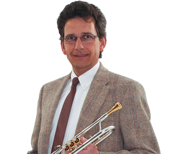Hierarchy of an orchestra the responsibility of orchestra musicians
Any orchestra is based on a hierarchical system of voices and functions. A 2nd voice is not a lead voice and must therefore be subordinated to the lead voice. See also my workshop "Section sound"”a unity." All members of a section need to be concerned about the sound of their section, and all sections need to serve the orchestra’s overall sound. The 1st trumpet, or the 1st horn furthermore needs to see to it that the section in question sounds convincing.
I remember my father asking the members of his trombone section to create "homogeneity". Which means: with respect to sound, dynamics and articulation, all sections parts need to accept and accompany the 1st part. And although discussions about musical issues are necessary and welcome, the 1st part has the final word (in aviation, people say that the pilot is in command). At the section level, there can be no emancipation of the various parts: everybody needs to adapt, even though nobody should feel oppressed. Adapting is not the same as submitting, but rather the acceptance to play a supporting role by means of a good 2nd/3rd/4th part. There may be cases in which these fundamental rules should be neglected, yet one rule should always be heeded to: the lower parts need to support the higher parts by accompanying them.
The conductor-the spiritus rector
The entire orchestra is headed by the conductor who needs to be a born leader and also have a convincing idea about how the music at hand should be performed. I remember a few dress rehearsals where the lead parts and the concertmaster thought they had to question the conductor and one another. Such "battles" inevitably lead to a disaster and an orchestra that sounds nowhere near a unity. The most fundamental rule is that all members of the orchestra need to decipher the conductor’s movements and possibly even be able to conduct the orchestra themselves. The 6/8 time signature, for instance, can be indicated in a variety of ways, and gestures and expressions can differ wildly. Some conductors use flamboyant movements that tend to confuse the orchestra.
Orchestra musicians should not be put off by such aspects and rather focus on the essence. I sometimes look the conductor straight in the eye, because such eye contact is very precise and authentic. In the case of flamboyant "show conductors", keeping your eyes on the score to only vaguely notice the movements going on at the front is more than enough. The most important information for orchestra musicians is to know for sure where a beat or measure is finished, because they need to start playing at the right moment. Unfortunately, quite a few conductors are inconsistent in this respect, making it difficult for wind players to decide when to start and stop. In some cases, musicians need to decide for themselves and perhaps even lead the other members of their section. Most of these scenarios already emerge during rehearsals, and most conductors happily accept reasonable initiatives by individual musicians.
Playing together means supporting one another
Playing in an orchestra can be a challenge for a musician’s adaptability and reaction time. He or she must be able to respond immediately and to change tack if necessary. Orchestra musicians must be able to notice new drives arising from the performance and to interpret them correctly. They must be able to play each passage in different ways and to accept interpretations that may run counter to their own understanding or feeling.
A perfect section gives and takes on a constant basis. Collaboration to achieve a tight section sound, to balance the various parts, to do justice to the melody part, while also listening to, and discussing, justified suggestions"”all this is part of a musical ensemble. A 2nd part that goes beyond the dynamics of the 1st part is inconsiderate and only weakens the 1st part. Collective responsibility also shows in counting rests for a colleague who is seconds away from a difficult passage. Nods or signs (invisible to the audience) for colleagues create an atmosphere of confidence and calm.
Therefore, let’s not just talk about colleagueship"”let’s practice it.
Playing in an orchestra for years and years does not blunt talented musicians"”it helps them develop their ability and hence play even better; just look at a few famous orchestras. Orchestra musicians must be able to understand non-verbal signs and moods and to guess the intentions of conductors who use their body movements much too sparingly. Attention and alertness are the basic requirements for musicians in top-notch orchestras.
And the solo part?
The solo part is the star whom the orchestra, the conductor and the audience expect to show off his or her virtuosity. Only the composer and the work in question rank above the soloist.
Obviously, the solo part is demanding"”you need to master your instrument and have strong nerves. And let’s not forget the visual element, for soloists also need to "sell" themselves to the audience. Yet, without an orchestra, there is no concerto or solo performance. The musicians in the orchestra and the soloist therefore need one another, albeit that they need to meet totally different requirements. In short: orchestra musicians need to develop what philosophers and ethicists demand from the "self-conscious individual""”the ability to defer and commit to the common cause.
In that respect, orchestra musicians are indeed first-rate musicians.
Have fun and all the best!


